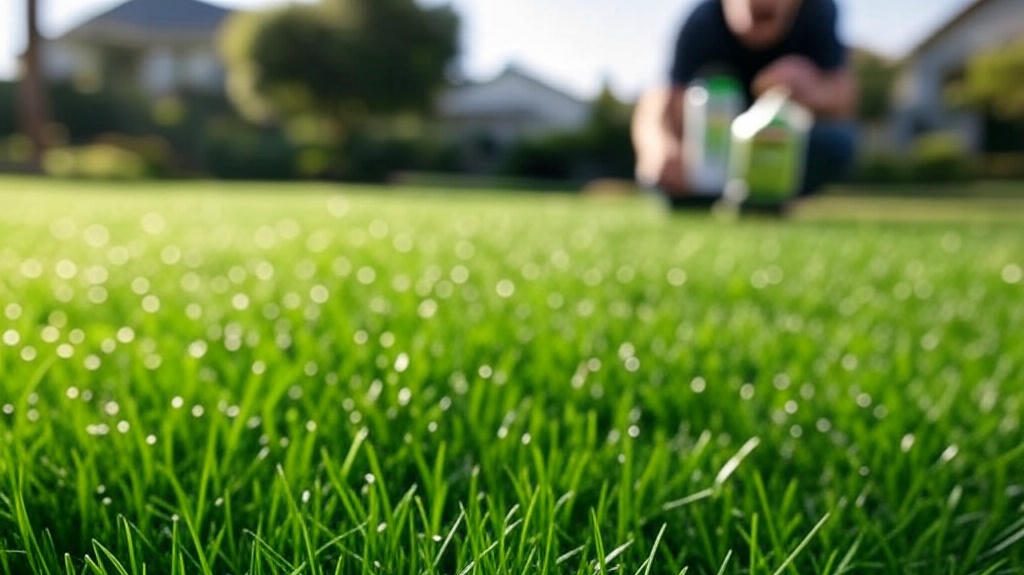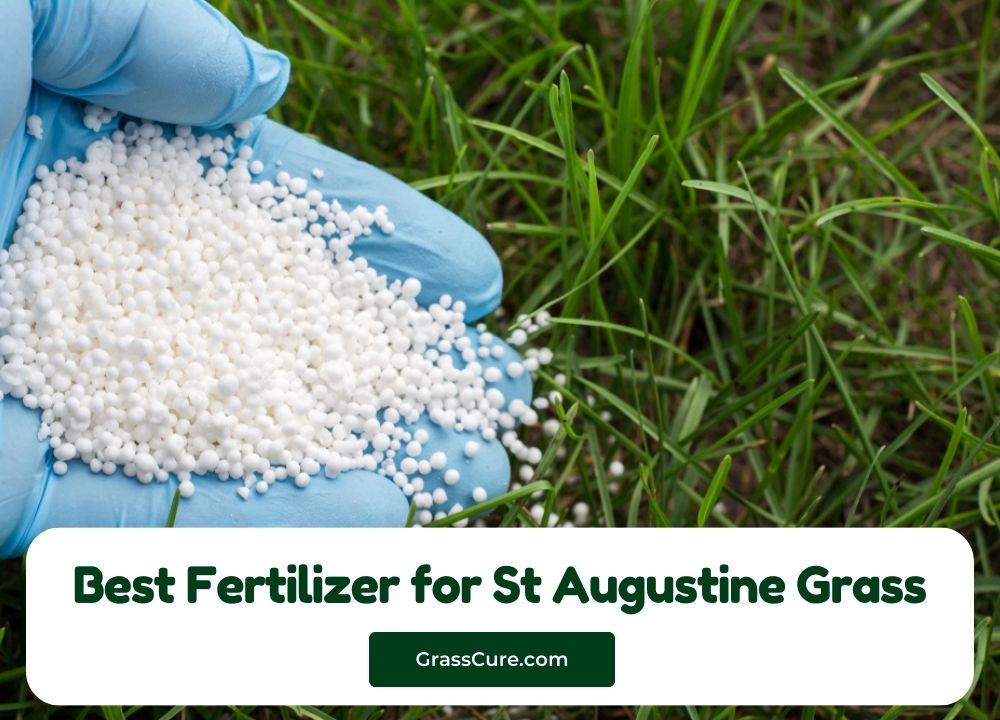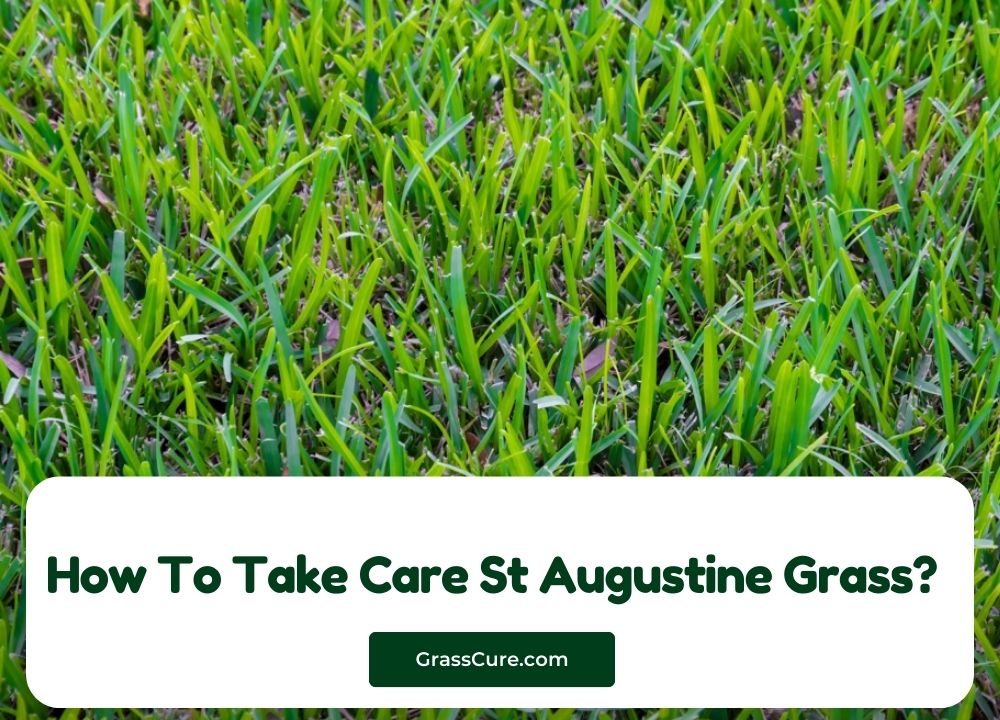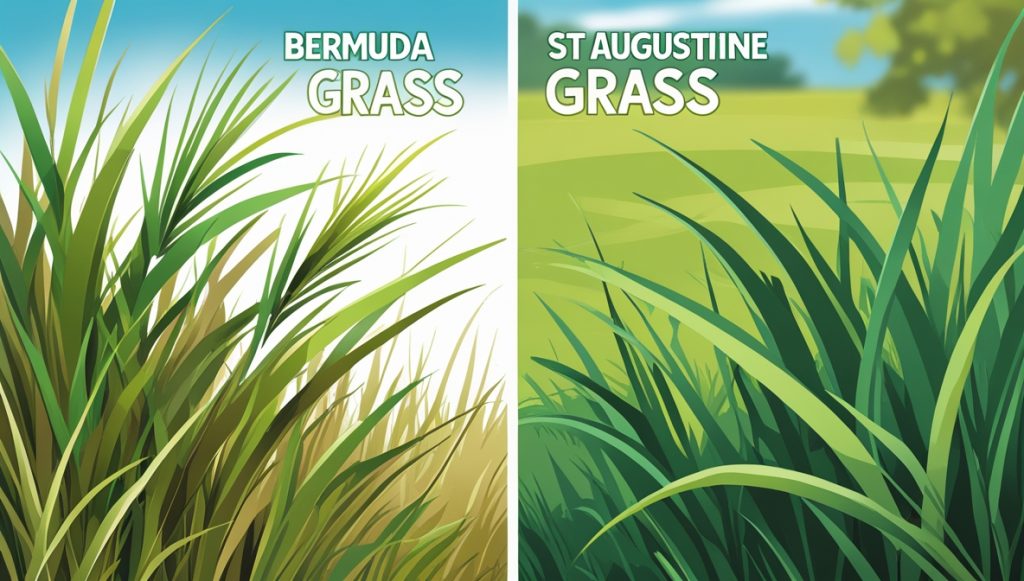St. Augustine grass creates a lush, carpet-like lawn that thrives in warm climates. Yet maintaining this beautiful turf requires the right combination of nutrients and weed control. Weed and feed products simplify lawn care by combining fertilizer and herbicide in one application. This saves time, money, and effort while promoting a healthy, weed-free lawn.
Finding the perfect weed and feed for St Augustine grass demands careful consideration. The wrong product can damage or even kill this sensitive grass variety. Our comprehensive guide explores the top products specifically formulated for St. Augustine grass in 2025, helping you make an informed decision for your lawn care needs.
Contents
- Understanding St. Augustine Grass Needs
- Top 5 Weed and Feed Products for St. Augustine Grass
- When to Apply Weed and Feed to St. Augustine Grass
- How to Apply Weed and Feed to St. Augustine Grass
- Common St. Augustine Weeds Controlled by Weed and Feed Products
- Safety Considerations When Using Weed and Feed Products
- Alternatives to Chemical Weed and Feed Products
- Troubleshooting Common Weed and Feed Issues
- Final Verdict: Which Weed and Feed is Best for Your St. Augustine Lawn?
- Conclusion
- Frequently Asked Questions
Understanding St. Augustine Grass Needs
St. Augustine grass stands out from other warm-season grasses with its specific care requirements. This thick, blue-green turf grows vigorously in tropical and subtropical regions, making it popular throughout the southern United States.
St. Augustine grass requires:
- Nitrogen-rich fertilizer with appropriate NPK ratios
- Selective herbicides that target weeds without harming the grass
- Products formulated specifically for St. Augustine’s sensitivity
- Proper timing of applications during active growth periods
Using the wrong weed and feed products risks lawn damage or failure to address weed problems. Generic products often contain chemicals too harsh for St. Augustine grass, potentially causing yellowing, thinning, or entire lawn sections dying off.
Top 5 Weed and Feed Products for St. Augustine Grass
After extensive testing and research, we’ve identified the five best weed and feed products specifically designed for St. Augustine grass. Each product balances effective weed control with proper nutrition for this unique grass variety.
1. Fertilome (13915) St. Augustine Weed & Feed 15-0-4 (12.8 lbs.)

Fertilome’s specialized formula targets St. Augustine grass needs with precision. The 15-0-4 NPK ratio provides ideal nitrogen levels while avoiding excessive phosphorus that might contribute to water pollution.
Pros:
- Contains atrazine, highly effective against broadleaf weeds in St. Augustine lawns
- Slow-release nitrogen promotes steady growth without burning
- Covers approximately 5,000 square feet per bag
- Controls over 25 common lawn weeds including dollar weed and clover
- Safe for St. Augustine grass when applied correctly
Cons:
- Not suitable for newly seeded areas (wait until after third mowing)
- Cannot be used on certain St. Augustine varieties like Floratam in some regions
- Requires careful application to avoid runoff
Best for: Established St. Augustine lawns with moderate weed problems. The iron content promotes deep green color while the specialized herbicide blend targets stubborn weeds without damaging the grass.
2. Sunniland Weed & Feed 20-0-6 Lawn Fertilizer 5000 sq. ft. for St. Augustine
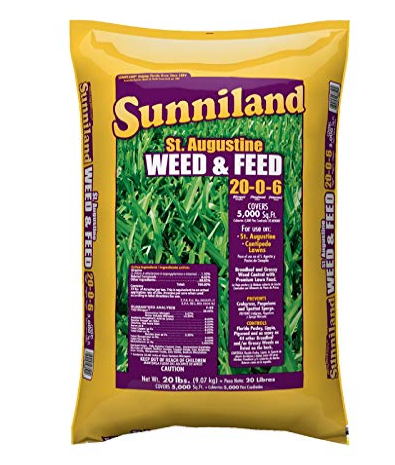
Sunniland brings decades of Florida-based expertise to their St. Augustine weed and feed formula. The higher nitrogen content promotes vigorous growth while potassium strengthens grass against heat stress.
Pros:
- Specially formulated for St. Augustine grass including Floratam varieties
- Contains 2,4-D and other selective herbicides targeting specific St. Augustine weeds
- Extended feeding lasts up to 8 weeks
- Includes micronutrients specific to southeastern soil deficiencies
- Granular formula allows for easy, even distribution
Cons:
- Higher nitrogen requires precise application to prevent burning
- Should not be applied during drought conditions
- May require watering within 24 hours of application
Best for: St. Augustine lawns needing significant green-up while controlling broadleaf weeds. The higher potassium content makes this ideal for lawns facing high heat stress or recovery from winter dormancy.
3. LESCO 50 lb. St. Augustine Grass Weed and Feed with Penoxsulam
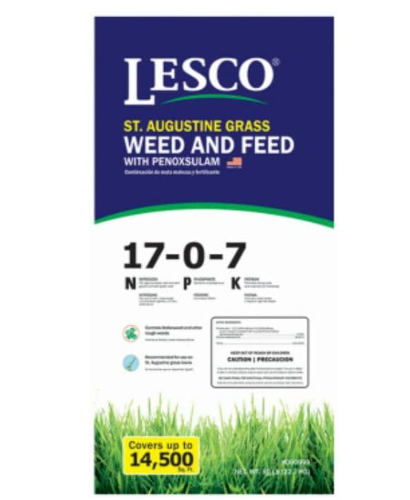
Professional lawn care companies often choose LESCO products for their reliability and professional-grade results. This heavy-duty bag covers up to 12,500 square feet, making it economical for larger properties.
Pros:
- Contains penoxsulam, highly effective against sedges and broadleaf weeds
- Professional-grade formula with extended-release technology
- Lower burn potential than many competitor products
- Effective in controlling dollarweed, a common St. Augustine problem
- Includes trace elements for complete nutrition
Cons:
- Higher price point than consumer-grade products
- Heavy bag requires proper storage and handling
- Not readily available in all retail locations
Best for: Larger St. Augustine lawns with persistent weed problems. The penoxsulam herbicide targets weeds that other products miss, including dollar weed and sedges that commonly plague St. Augustine grass.
4. BioAdvanced 3-in-1 Weed and Feed for Southern Lawns, Granules, 10 lb

BioAdvanced takes a comprehensive approach with their 3-in-1 formula that feeds grass, kills weeds, and prevents new weeds from emerging. This makes it ideal for St. Augustine lawns with recurring weed problems.
Pros:
- Triple-action formula for complete lawn care
- Controls over 200 weed types including tough southern varieties
- Prevents new weeds for up to 6 months
- Micro-granular formula spreads evenly
- Contains soil-enhancing ingredients for improved water retention
Cons:
- Less specialized for St. Augustine compared to some competitors
- May require more frequent application for best results
- Not ideal for new lawns or recently sodded areas
Best for: St. Augustine lawns with diverse weed problems and areas prone to weed reinfestation. The preventative barrier makes this an excellent choice for properties bordering natural areas or neighbors with weed issues.
5. Scotts Turf Builder Weed & Feed5, 11.32 lbs.
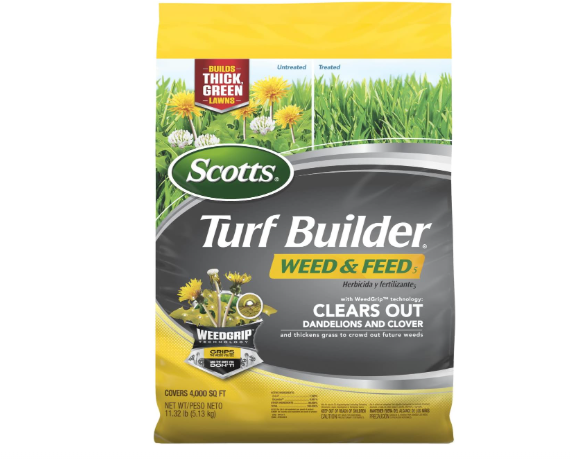
Scotts brings name recognition and widespread availability to the St. Augustine weed and feed market. Their Weed & Feed5 formula works effectively on warm-season grasses including St. Augustine when used according to instructions.
Pros:
- Trusted brand with consistent quality
- WeedGrip Technology claims to grab and kill tough weeds
- Feeds and strengthens grass against heat and drought
- Widely available at most garden centers and big box stores
- Covers up to 4,000 square feet
Cons:
- Less specialized for St. Augustine grass specifically
- Contains some ingredients that require careful application rates
- May not control certain St. Augustine-specific weeds as effectively
Best for: Young or recently established St. Augustine lawns needing gentle care while controlling common weeds. The balanced approach works well for homeowners seeking a recognized brand with reliable results.
When to Apply Weed and Feed to St. Augustine Grass
Timing significantly impacts weed and feed effectiveness on St. Augustine grass. Following these guidelines maximizes results while minimizing potential damage:
Spring Application (March-April):
- Apply when St. Augustine fully greens up after winter dormancy
- Target early-season weeds before they establish
- Provides nutrients for spring growth surge
Late Spring/Early Summer (May-June):
- Perfect timing for controlling summer annual weeds
- Supports St. Augustine during peak growth period
- Apply before temperatures consistently exceed 90°F
Fall Application (September-October):
- Controls fall weeds while strengthening roots for winter
- Lower nitrogen content products preferred for fall application
- Helps grass recover from summer stress
Avoid application during:
- Extreme heat (above 90°F)
- Drought conditions unless you can water thoroughly
- Within 30 days of seeding or sodding
- Winter dormancy periods when grass isn’t actively growing
St. Augustine grass absorbs weed and feed products most effectively when:
- The lawn is moist (water lightly before application if needed)
- Weeds are actively growing
- No rainfall is expected for at least 24 hours
- Temperatures remain between 65-85°F for several days
How to Apply Weed and Feed to St. Augustine Grass
Proper application techniques ensure effectiveness while preventing lawn damage:
- Mow the lawn 2-3 days before application.
- Water lightly the day before application if soil is dry.
- Apply in the early morning when dew is present on the grass.
- Use a proper spreader calibrated to the product specifications:
- Broadcast spreaders work best for larger lawns
- Drop spreaders provide more control near garden beds
- Hand spreaders work well for small areas
- Apply evenly without overlapping passes.
- Keep off the lawn until the product has settled (usually 24-48 hours).
- Avoid watering for 24 hours after application (unless product directions specify otherwise).
- Clean your spreader thoroughly after use to prevent corrosion.
Most weed and feed failures result from improper application. Follow package directions precisely regarding:
- Application rates
- Coverage area calculations
- Weather conditions
- Watering instructions
- Waiting periods between applications
Common St. Augustine Weeds Controlled by Weed and Feed Products
Quality weed and feed products target specific problematic weeds in St. Augustine lawns:
Broadleaf Weeds:
- Dollarweed (pennywort)
- Clover
- Dandelion
- Chickweed
- Henbit
- Oxalis
- Spurge
Grassy Weeds:
- Crabgrass
- Annual bluegrass
- Goosegrass
- Foxtail
Sedges:
- Yellow nutsedge
- Purple nutsedge
- Globe sedge
Certain weeds prove particularly challenging in St. Augustine lawns. Dollar weed thrives in the same moist conditions St. Augustine prefers. Sedges often resemble grass but require specific herbicides found only in certain weed and feed formulations. The best products contain multiple herbicide types to address this diverse weed spectrum.
Safety Considerations When Using Weed and Feed Products
Weed and feed products contain powerful chemicals requiring responsible handling:
For People and Pets:
- Wear gloves, long sleeves, and pants during application
- Keep pets off treated areas until completely dry (usually 24-48 hours)
- Store products in original containers out of reach of children
- Wash hands thoroughly after handling
- Follow all label safety precautions
For Environmental Protection:
- Avoid application before heavy rain to prevent runoff
- Keep product off driveways, sidewalks, and other impervious surfaces
- Never apply directly to water features or near water sources
- Dispose of empty containers according to local regulations
- Consider using phosphorus-free formulations where legally required
For Plant Protection:
- Maintain proper distance from tree drip lines
- Avoid application around vegetable gardens
- Use caution near ornamental plants sensitive to herbicides
- Never exceed recommended application rates
Alternatives to Chemical Weed and Feed Products
Some homeowners prefer more natural approaches to lawn care:
Organic Options:
- Corn gluten meal (natural pre-emergent)
- Compost tea fertilization
- Vinegar-based organic herbicides
- Iron-based weed control products
Cultural Practices:
- Proper mowing height (3-4 inches for St. Augustine)
- Deep, infrequent watering
- Core aeration to reduce compaction
- Topdressing with compost
- Hand-pulling isolated weeds
While these alternatives typically work more slowly than chemical options, they build long-term soil health and minimize environmental impact. Many homeowners combine limited chemical use with natural practices for balanced lawn care.
Troubleshooting Common Weed and Feed Issues
Even with careful application, problems sometimes occur:
Burning or Yellowing:
- Cause: Overapplication or applying to wet foliage
- Solution: Water thoroughly to dilute chemicals and prevent further damage
Streaking or Uneven Results:
- Cause: Improper spreader calibration or application pattern
- Solution: Apply perpendicular to previous application pattern in half-rate passes
Weeds Not Dying:
- Cause: Application during incorrect growth stage or wrong product for weed type
- Solution: Identify specific weeds and target with appropriate spot treatment
Grass Thinning After Application:
- Cause: Product incompatible with specific St. Augustine variety
- Solution: Switch to more specialized St. Augustine formula and follow rehabilitation protocols
Final Verdict: Which Weed and Feed is Best for Your St. Augustine Lawn?
After thoroughly evaluating the top five weed and feed products for St. Augustine grass, we can offer specific recommendations based on common lawn situations:
For Overall Performance: Fertilome St. Augustine Weed & Feed This product balances effective weed control with proper nutrition specifically formulated for St. Augustine grass. The atrazine-based herbicide targets the broadest spectrum of weeds while remaining gentle on St. Augustine varieties. The price point offers excellent value for the specialized formulation.
For Professional Results: LESCO St. Augustine Grass Weed and Feed Lawn care professionals choose this product for its reliable performance and complete nutrition package. The penoxsulam herbicide controls even the most stubborn weeds while the slow-release nitrogen prevents burning. Though more expensive, the coverage area and results justify the investment for larger properties.
For Beginners: Scotts Turf Builder Weed & Feed5 First-time St. Augustine owners appreciate the straightforward application and widely available support for Scotts products. The balanced formula provides good results without requiring expert knowledge of lawn care chemistry. The trusted brand name provides peace of mind for those new to lawn maintenance.
For Serious Weed Problems: BioAdvanced 3-in-1 Weed and Feed Properties with significant weed pressure benefit from the triple-action formula that kills existing weeds while preventing new ones. The extended protection period reduces the need for frequent reapplication, saving time and money over the growing season.
For Florida Lawns: Sunniland Weed & Feed 20-0-6 Developed specifically for Florida conditions, this product addresses the unique challenges of growing St. Augustine in its native environment. The micronutrient package corrects common sandy soil deficiencies while the herbicide blend targets regional weed varieties.
Conclusion
Selecting the right weed and feed product transforms St. Augustine lawn care from frustration to satisfaction. The right formula controls weeds without damaging your sensitive grass while providing essential nutrients for thick, green growth.
Consider your specific lawn conditions, weed pressure, and environmental concerns when selecting from our top recommendations. Remember that proper application timing and technique prove just as important as product selection. With the information in this guide, you’re equipped to make an informed decision that will result in the lush, weed-free St. Augustine lawn you desire.
Whichever product you choose, consistent lawn care practices enhance weed and feed effectiveness. Proper mowing height, irrigation discipline, and seasonal maintenance combine with strategic weed and feed application to create a lawn that becomes the envy of your neighborhood.
Frequently Asked Questions
Can I use regular weed and feed on St. Augustine grass? No. St. Augustine grass requires specialized formulations. Regular weed and feed products often contain herbicides that damage or kill St. Augustine grass. Always choose products specifically labeled safe for St. Augustine varieties.
How often should I apply weed and feed to St. Augustine grass? Most quality products require application just twice yearly – once in spring and once in fall. Excessive application can damage grass and create environmental concerns. Follow product labels for specific timing recommendations.
Will weed and feed kill crabgrass in my St. Augustine lawn? Most weed and feed products control established crabgrass poorly. For best results, use a pre-emergent crabgrass preventer in early spring before soil temperatures reach 55°F, then follow with weed and feed later in the season.
Is weed and feed safe around trees and shrubs? Keep weed and feed products away from the drip line of trees and ornamental plantings. The herbicides can damage or stress non-target plants through root absorption. Create buffer zones around landscape plantings when applying.
Can I seed or sod after applying weed and feed? Most weed and feed products prevent seed germination. Wait at least 4-12 weeks (check product label) before seeding or sodding. For existing St. Augustine lawns, this rarely causes issues since renovation typically occurs through plugs or sod rather than seeding.
Why did my grass turn yellow after applying weed and feed? Temporary yellowing sometimes occurs as the herbicide component stresses the grass while targeting weeds. This typically resolves within 7-14 days. Persistent or severe yellowing indicates improper application, excessive rate, or application during environmental stress periods.
Can I apply weed and feed in summer? Avoid summer application when temperatures exceed 85-90°F. High temperatures increase the risk of burning and stress on St. Augustine grass. Spring and fall applications prove much safer and more effective for both weed control and fertilization.
